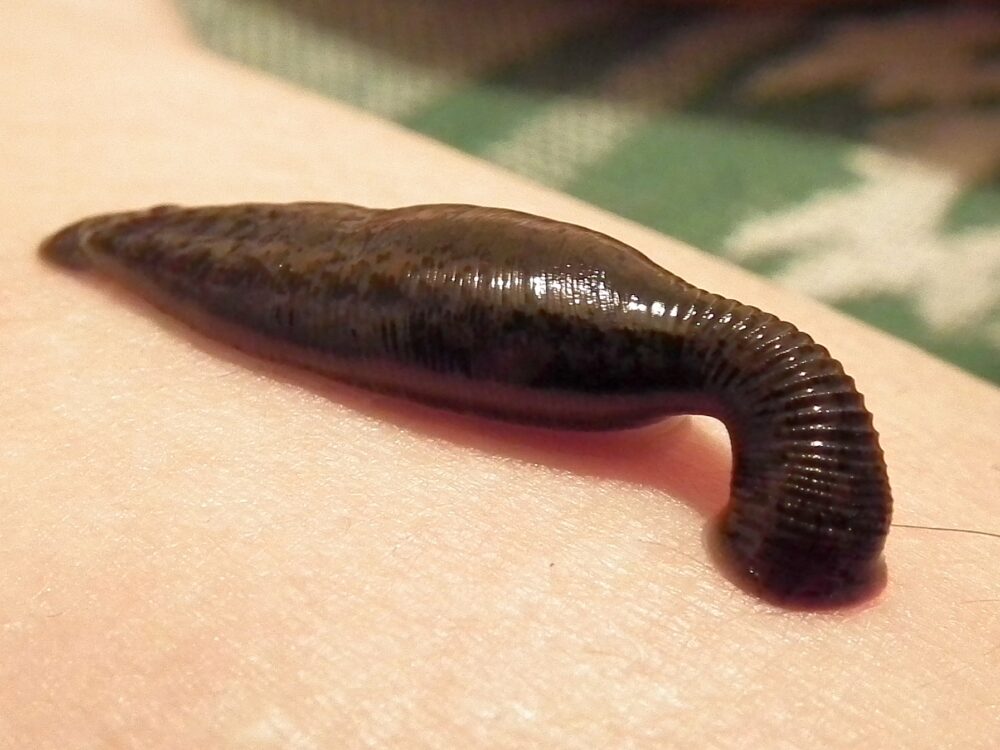Barking deer. Silky-haired monkeys. Rabbits covered in stripes. For years, scientists struggled to detect the unique and elusive mammals of the Central Annamite Mountains. This region of dense tropical rainforest on the border of Laos and Vietnam is a biodiversity hotspot, full of organisms found nowhere else on Earth. Unfortunately, the area is so remote and its inhabitants so rare that monitoring Annamite species is nearly impossible using traditional methods. As a result, scientists have struggled to determine the habitat range and conservation status of many of the ecosystem’s mammals. But biologists have begun to solve this problem by enlisting an unusual set of helpers: leeches.
When a leech feeds on a mammal, proof of its meal lingers in its digestive tract for a surprisingly long time. Researchers in Copenhagen, Denmark, and Cambridge, England, found that when leeches in the genus Hirudo were fed goat blood, the goat’s DNA remained detectable in their guts for over four months. Hoping to capitalize on the persistence of mammalian DNA in leeches, the scientists traveled to the Central Annamites to see if leeches in the wild would offer evidence of their recent mammalian victims. The researchers collected 25 leeches, and, remarkably, detected mammalian DNA in 21. Among the species detected were the newly discovered Truong Son muntjac, the endangered Annamite striped rabbit, and the small-toothed ferret badger, Melogale moschata. The small-toothed ferret badger is considered a cryptic species, meaning that it is impossible to distinguish from another ferret species just by looking at it. However, by analyzing its DNA — in this case with the help of a well-fed leech — scientists can make the distinction. Perhaps most impressive was the ease of the collection process. Most of the leeches sampled had crawled onto the researchers’ clothing and simply had to be picked off and transported back to the lab. Evidence of Annamite mammals, which was previously so difficult to come by, had been delivered directly to the scientists seeking it.
Since this first detection of vertebrate DNA in leeches, scientists have utilized leech-derived DNA for a variety of applications. Park rangers in China’s Ailaoshan Reserve collected over 30,000 leeches in an effort to evaluate the biodiversity of the protected area. Researchers identified the DNA of 86 different vertebrate species in these leeches and determined that a greater diversity of vertebrates were found at higher elevations within the reserve. This finding suggests that human presence at lower elevations, close to the edge of the reserve, disturbs wildlife and thus provides crucial information about the effectiveness of the area’s protected status.
Even leeches that were collected for completely different purposes can be utilized for vertebrate detection. In collaboration with the American Museum of Natural History, scientists successfully identified vertebrate DNA in the guts of leeches collected over ten years prior. These leeches were sampled and preserved before the technique had been invented but yielded valuable information nonetheless. Natural history collections of leeches provide a snapshot of the past, indicating which vertebrates were present in a specific area at a specific point in time. This historical data can help scientists understand how the ranges of animals are changing — information that is crucial as climate change progresses.
“Evidence of Annamite mammals, which was previously so difficult to come by, had been delivered directly to the scientists seeking it.”
“Leeches are fantastic at capturing the blood of small mammals, which many traditional sampling strategies struggle to detect.”
Scientists continue to hone the technique of sampling through leech-derived DNA, identifying its potential applications and shortcomings. DNA extracted from leech guts can of course only be used to detect the animals that leeches feed on, excluding animals that live in trees and other hard-to-reach habitats in addition to any animal a leech simply prefers not to target. Therefore, the absence of an animal’s DNA in sampled leeches doesn’t necessarily indicate the absence of that species. However, leeches are fantastic at capturing the blood of small mammals, which many traditional sampling strategies struggle to detect. As an additional advantage, collecting leeches requires minimal training and can easily be integrated into the job of a park ranger. Analyzing leech-derived DNA can best be utilized as one of many biodiversity sampling techniques. Along with live traps, camera traps, and animal track surveys, leeches have become a tool that allows scientists to uncover the diversity of life in some of the world’s most extraordinary ecosystems.
Image courtesy of Wikimedia Commons

